HOT BED PCB
What is 3D printer hot bed plate?
3D printer PCB Heated is an essential part of 3D printer operation. The PCB heating bed was developed by Josef Prusa, the initial model size: 214x214mm, with an active heating area of 200x200mm. Therefore, all subsequent new 3D PrinterHOT BED designs will always be based on this model.
HOT BED circuit board mainly has two-point hotbed (one resistance circuit) and three-point hotbed (two resistance circuits). All projects made by 3D printers are done in this place. It plays a vital role when printing complex and delicate projects and when using special filament materials such as ABS, Nylon and PETG. Before we officially start printing, we need to find out the appropriate temperature for the conversion of the filament in your hand through experiments.
The working principle of the 3D Printer Hot Bed Board is based on the theory that when an electric current passes through a conductor, it generates heat proportional to the amperage flowing through it. For example, the heating can be set as low as 120W or 200W depending on 12 or 24V needs.
The higher the resistance, the lower the current and the lower the power. Trace resistance determines how many watts the process will draw. Therefore, care should be taken to control the current to avoid overloading the PCB traces. Because if it exceeds a certain limit, it will lead to the possibility of burning the PCB track. Click to learn more comprehensive PCB routing knowledge.
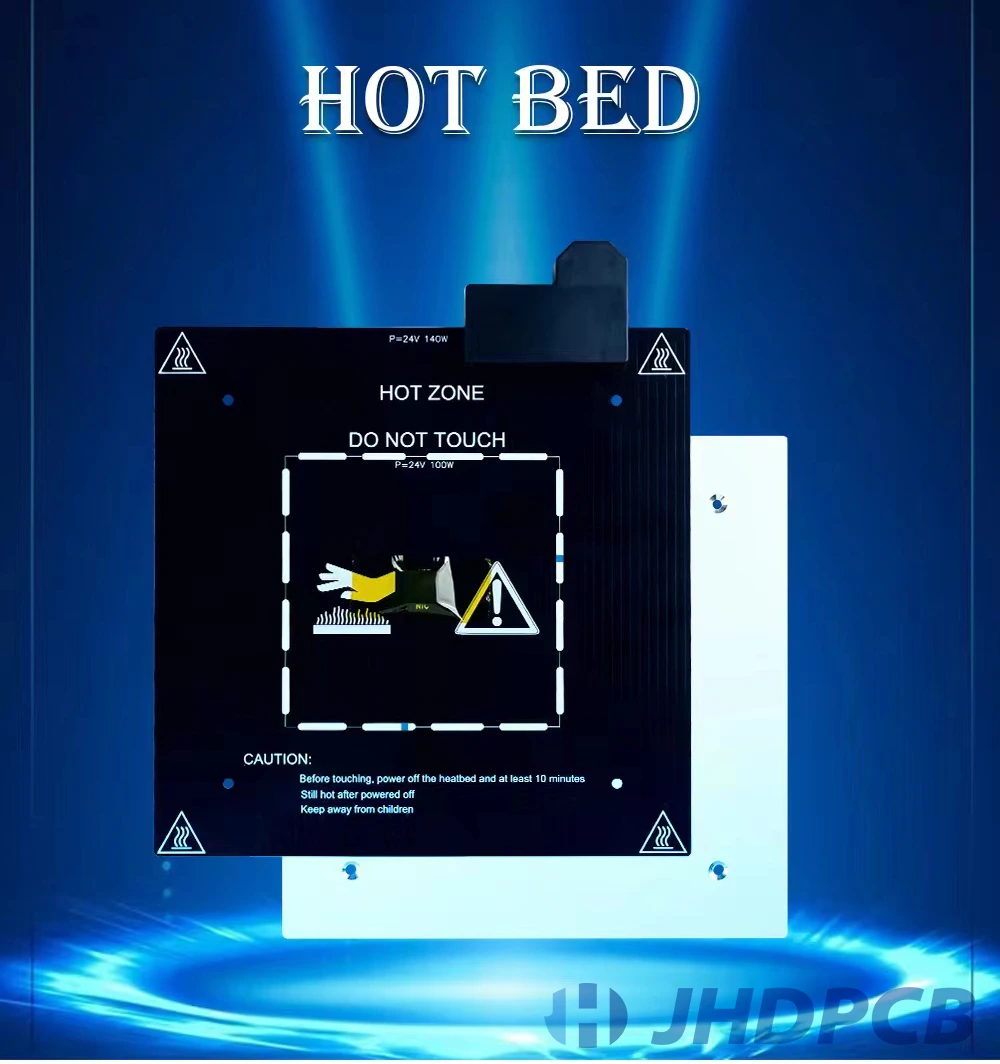
How does a PCB heated bed help in 3D printers?
The PCB heated bed is heated to different temperatures according to actual needs. In order to maintain a constant temperature in the 3D printing area, improve the printing quality and reduce the possibility of printing failure. Without enough heat underneath the model, you run the risk of the filament cooling too quickly, causing stringing and warping of the edge corners. Sometimes it even cracks in the middle part of the model. 3D PrinterHOT BED provides excellent layer adhesion for the entire printing process to reduce the probability of failure. The following is the role of PCB Heated Bed in the 3D printing process.
To maintain the temperature of the printing area:
In the past, 3D printing was only used for some simple projects. Heated beds were relatively rare in 3D printers back then. Nowadays, the application of 3D printing technology is more extensive and more sophisticated. Therefore, in order to prevent the premature cooling of the filament during the printing process and affect the finished product, 3D printer heated beds have become more and more common.
It maintains the temperature of the 3D printing area and slows down the cooling rate of the printed object. The reduction in material stress can help the printed material perform at its best until the print is complete.
Note that some heated beds do not cover the entire size of the print bed, they only heat a certain area. This will cause an uneven temperature on the print surface, so you’ll want to wait a few minutes for it to heat up before testing the temperature across the surface. Make sure that the heat is distributed evenly and not concentrated on the sides or in the middle.
Of course, in some particularly delicate commercial printing processes a heated chamber or enclosure is used. Its heating method is not limited to a plane, but the entire three-dimensional space. This space can maintain a good constant temperature, effectively preventing warping of printed matter. At the same time, since the printing environment is isolated, excess heat can be reduced to reduce operating costs.
Prevents Warping and Deformation:
Stress is inevitable when a hot (expanding) material is squeezed together with a cold (shrinking) material. Warping often occurs when hot and cold materials cool at different rates. The cooled plastic shrinks upwards changing the appearance of the print.
The biggest factor affecting the degree of warpage of the printed part is the difference between the TG value (glass transition temperature) and the cooling temperature of the printing process. So the 3D PrinterHOT BED can reduce the amount of cooling of the front layer before the material of the next layer is extruded. PCB Heated Bed can prevent material warping in two ways:
- Heating the surface of the machine tool to the critical point where the printed parts adhere better;
- Keep the material warm throughout the printing process by thermal radiation.
We can choose the corresponding hot bed temperature according to different printing materials. For example: ABS has a Tg of 212F and PLA has a low Tg of 122°F. They all process at different temperatures, and some materials can warp more easily than others. If you are not sure how high temperature your material needs to be provided by HOT BED PCB, you can contact JHD, and we will give you the best suggestion based on your project.
Severe warping will result in damage to the printed matter and turn it into a waste product. So a quality and reliable heated bed can save a lot of cost, time and frustration. Of course, 3D printer HOT BED is not the only solution to deformation. It is just one important factor, and combining it with others can make the printing process more efficient.
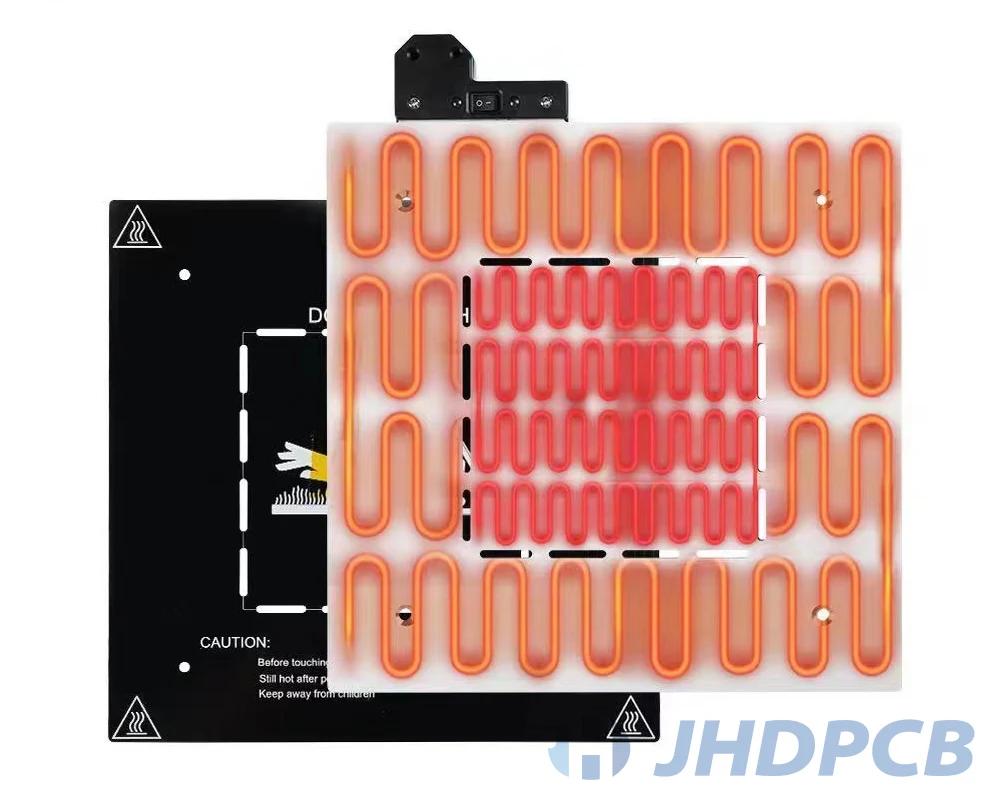
Improve first layer adhesion:
Professional 3D printing engineers know that the first layer of base material is very important for the subsequent printing process. The surface of the 3D printing table is very durable but also smooth. If the adhesion of the first layer of material is not good. Then the adhesion ability of the print will be reduced, and the probability of failure will increase.
The 3D printer hot bed plate can make the material in a viscous state to improve filament adhesion. Of course, since the material of the machine table is different from the type of filament, the performance of adhesion is easy to change. We can try different temperatures, gradually increasing or decreasing the temperature to find the most suitable conditions for the moment. You’ll need to do some trial and error to find the most effective method before printing.
Easy removal:
How to remove the print from the machine is also a problem when it is finished. In the past, people needed tools to scratch the surface to remove the print. But that can ruin the print, and you might cut yourself sometimes.
Now, HOT BED PCB can help you easily remove the complete print from the machine tool. When the heated bed cools down, it hardens due to the rubbery state of the printed material. The finished product can then be removed easily.
JHD's HOT BED circuit board manufacturing capability.
| Specification | Capability Tolerance |
|---|---|
| Shape | Square/Round/Hexagonal/Support customization |
| Hot bed substrate material | FR-4/silicone rubber/aluminum/PEI spring steel magnetic plate |
| Voltage | 12V/24V/120V/customized |
| Power | 100-750W/customized |
| Board Size | 180*180mm-550*550mm/support customized size |
| Heated area | 160*160mm-500*500mm/support customized size |
| Thickness | 2-3mm/support customized thickness |
| Solder mask ink | White/Black Oil |
| Silk screen color | White/Red/Yellow/Blue/Green/Customized |
| HOT BED PCB max temperature | 260°C |
| Positioning hole distance | Support customized distance |
| Hole type | Through hole / Blind hole / Mounting hole / Countersink hole |
| Hole Diameter | 2.8-12mm/support customized size |
| Special handling | PEI/Frosted/Brushed |
| Supported Power Types | DC/AC |
| Standing Stock Models | MK2/MK2a/MK2B/MK2i/MK3/MK3 ALU |
How to fix the hot bed plate of 3D printer?
A regular 3D printer heated bed has at least four mounting holes, which we can use to fix it on the printer’s support structure. But the natural warping of HOT BED PCB still exists. Therefore, we recommend covering the surface of the HOT BED PCB with a countertop: a flat surface made of polypropylene, metal, glass and ceramics. Fix and correct the machine table and the PCB heating bed by using horn clips or snap-fitting accessories of the 3D printer.
At the same time, because there are copper traces on the bottom and top of the 3D printer hot bed plate (some 3D PrinterHOT BED PCBs only have single-sided traces). The additional bed platform can effectively protect the copper traces of the HOT BED PCB. It also helps to improve upward heat transfer, enabling even heating of the 3D printing table. Using the HOT BED circuit board with lens helps to enhance heat transfer and make the machine heat up faster. Cleaning is also easier after the print is complete. However, please be careful to avoid damage caused by collision between the machine table and the spring accessories of the 3D printer.
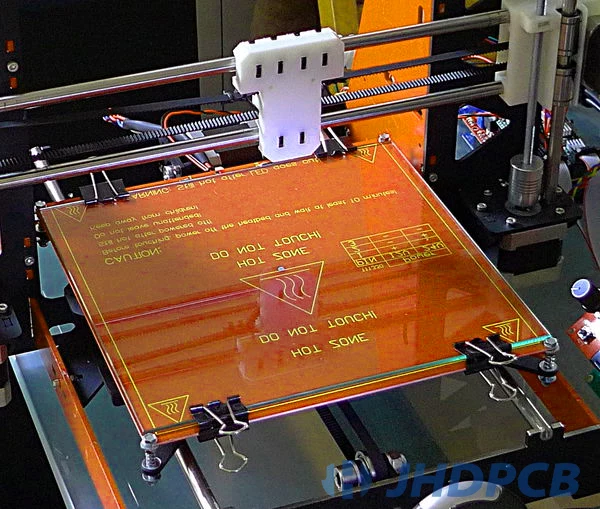
How to check if the 3D printer HOT BED is working properly?
Make sure to check that the 3D printer HOT BED is working properly before starting to print. Avoid the waste of cost and time caused by the error of HOT BED circuit board. The following are some common faults and countermeasures to check.
No heating:
When the 3D printer hot bed plate is not heating, it is necessary to use a multimeter to check the electrical continuity of the overall connection line.
Uneven heating:
If HOT BED PCB cannot provide uniform heating, it will directly affect the quality of printed products. Uneven heat can cause stringing and partial warping of prints. Usually, the temperature difference between the center and the periphery of the hot bed is about 3 degrees Celsius, and the corners will be cooler. We recommend to preheat the HOT BED PCB before printing, and check whether the plane temperature is consistent before starting the official printing.
Insufficient temperature or taking too long to reach temperature:
This is the most common problem encountered by 3D printing operators. There are many reasons why this happens, here are some common causes and what to do about them:
Faulty Resistance – Use a multimeter to measure the resistance of the heatbed. If the HOT BED circuit board resistance is too high, it cannot get enough current, and the PCB Heated Bed cannot dissipate enough heat to reach the desired temperature.
Pass Voltage Fault – If the board resistance is OK or below the set value, you can check the voltage across the heatbed terminals. If the voltage is too low, the heating bed cannot get enough current, and the lower the current, the lower the temperature.
Additional Cable Mismatch – Not all cables are uniform. Using matched-gauge cables for your 3D printer heated bed will ensure that the power supply provides the proper voltage under load conditions.
HOT BED PCB wiring design is unreasonable – a qualified 3D printer HOT BED should be reasonably designed according to the actual application scene wiring length, line width, copper thickness and line distance. An error in any of these items may affect the heated bed signal transmission. JHD is well aware of this, even though the manufacturing process of heated bed plates is very familiar to us. But we still treat every HOT BED PCB order with a rigorous attitude to ensure the normal operation of customers.
Running overheating:
The overheating of 3D PrinterHOT BED PCB’s continuous operation may produce a lot of unnecessary losses. Such as: damage to machine tools and deformation of printed parts. In severe cases, it may shorten the service life of the equipment and damage some parts of the 3D printer. Therefore, it is especially important to continuously pay attention to the temperature of the machine tool during the operation of the equipment. Once the temperature is found to be too high, it is necessary to take immediate stopping measures.
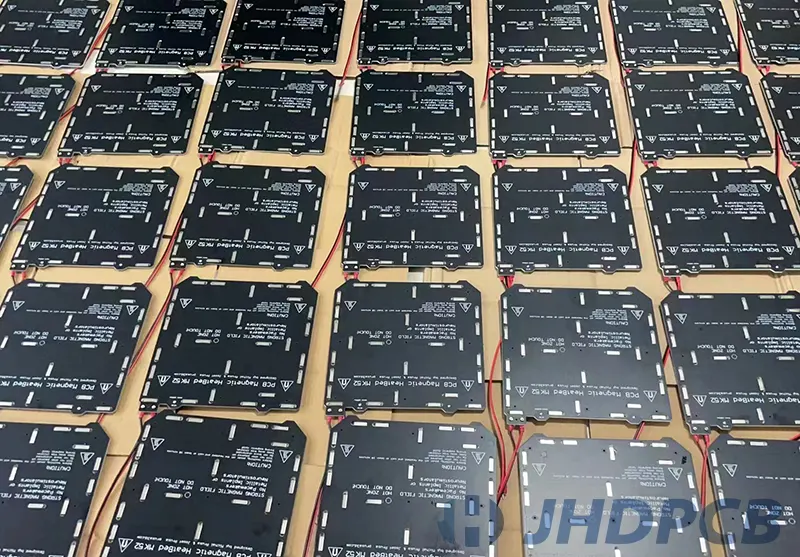
What materials are commonly used for 3D printer bed tops?
We have already mentioned the benefits of using the bed during the fixing process of the 3D printer hot bed board. However, there are many different materials for the 3D printer bed surface, such as: glass, polypropylene, G10, metal, ceramic, PEI film and kapton tape. Each material has its own advantages and disadvantages. There is no best among them, only the most suitable. You need to choose the right bed for your printer and filament. The following JHD will take you to understand their various characteristics, hoping to help you make a choice.
Glass:
Glass has always been the most widely used type of 3D printer bed. In fact, it is not ordinary glass but tempered glass. Tempered glass has the characteristics of high quality and high cost performance, and it can maintain a long shelf life even if it is heated.
The 3D printer glass bed surface has two different styles: smooth style and textured style.
As the name implies, smooth glass has a smoother surface. And textured-style glass makes prints easier to remove due to the texture of its surface.
Although glass takes longer to heat than other materials, its uniform heat dissipation makes the wait worthwhile. But please pay attention to the even distribution of heat on the HOT BED PCB to avoid glass breakage. Choose high-quality glass panels whenever possible to reduce the risk of breakage. Also, since glass is not sticky, additional adhesive is required to ensure the first layer adheres before printing.
Features: high cost performance, easy to pick up parts, even heat dissipation.
Applicable filament material: ABS, PLA, TPU, PETG, Nylon.
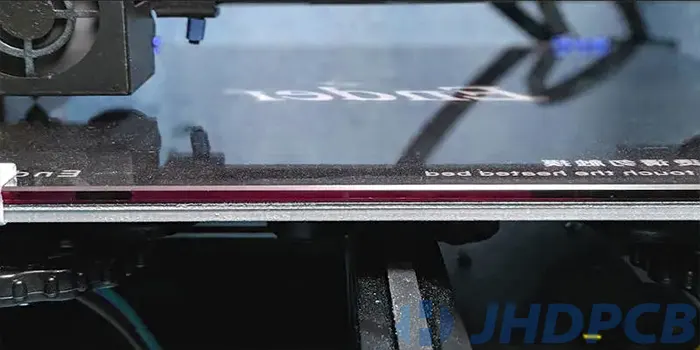
Polypropylene:
Polypropylene, also known as PP board, is a translucent plastic material. Although its shelf life is not as good as that of glass, its uniform and flat surface is comparable to that of glass. This plastic material can be used at a bed temperature of 120 °C and has low replacement costs. Polypropylene has high adhesion when heated, which can firmly bond the first layer to reduce the possibility of warping. The print can be easily removed after cooling.
Polypropylene is prone to deformation after being cycled through repeated heating and cooling. Once you notice this condition it means we should replace it.
Features: cheap, high temperature resistant, easy to pick up, semi-flexible.
Applicable filament materials: ABS, PLA, TPU, PETG, PC, nylon, polypropylene.
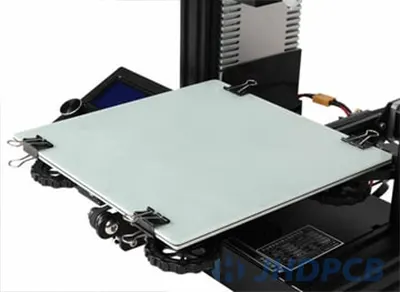
G10:
G10 is a material made of glass fiber and resin laminated, so it is also called FR4 or Garolite. It has the characteristics of high tensile strength, high modulus of elasticity, good impact resistance, good chemical stability, good fatigue resistance, high temperature resistance and so on. G10 is affordable and has excellent surface adhesion to most filament materials. Detailed G10 material properties can be learned through our blog.
Features: cheap, durable, strong adhesion.
Applicable filament materials: ABS, PLA, ASA, TPU, PETG, PET, Nylon.
Metal:
Because metal has high thermal conductivity, metal heat beds have the property of retaining heat and spreading it easily. However, most metal hot beds are customized for 3D printing equipment, and it is difficult for non-professionals to correctly and safely.
Good thermal conductivity can better distribute heat energy. But most metals expand slightly when heated, so you need to be aware of warping. The thinner the metal print bed, the easier it is to expand and bend.
Ceramics:
The characteristics of ceramic hot beds are similar to those of glass, and both have uniform thermal conductivity. However, ceramics are more heat-resistant than glass, and even if they are heated unevenly, ceramic plates are not easy to break. But since it is more expensive and bulky than glass, it is only used in special applications that require slow heating. Under normal circumstances, the cost performance of ceramic plates is not high.
PEI:
PEI spring steel is by far the most popular type of heated bed plate. It is made of PEI coating combined with spring steel plate, which can withstand high temperature of 260 degrees Celsius. It has the characteristics of no deformation under high temperature and scratch resistance.
The spring steel plate has the ability to deform elastically, so people can easily do it by bending the plate when picking up the print. PEI coating can provide excellent adhesion to printing filament without adhesive.
Features: Flexible, Magnetic, Cheap, Durable, Strong Adhesive.
Applicable filament materials: ABS, PLA, ASA, TPU, PETG, PET, Nylon.

Kapton Tape:
Kapton tape is also known as polyimide tape. Strictly speaking kapton tape is not a real floor, more like an add-on. Its adhesive side sticks to the machine table, and the additional polyimide provides amazing adhesion.
Kapton tape also has a very prominent feature, which can maintain adhesion at 280 degrees Celsius. Because it is adhered to the machine tool in the form of a plane, the unit price of the plane is extremely low. But the process of applying kapton tape on the print bed requires patience to ensure it is flat and free of bubbles.
Features: flexible, cheap, high temperature resistance, strong adhesion.
Applicable filament materials: ABS, PLA, PETG.
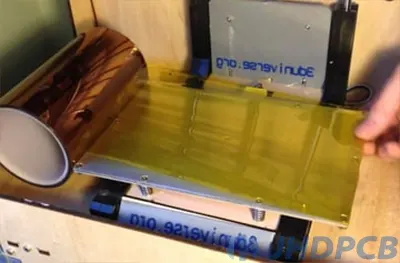
What filament materials are commonly used in 3D printers?
To make a good printed product, in addition to the printer, HOT BED circuit board and reliable heat bed, you need the right filament. ABS, PLA, PET, TPU, ASA, PETG, PC, Nylon and Polypropylene can all be used as the filament material for 3D printing. Below we will introduce the filament materials that are frequently used in 3D printing.
ABS: ABS material has super high strength and durability, and was the most common filament in 3D printing in the past. But since ABS is more prone to warping, the heated bed needs to be well temperature controlled. Avoid large temperature changes. ABS is often used to make some items that can withstand high temperatures and are strong.
PLA: PLA is made from a renewable resource and is odorless and non-toxic. While maintaining durability and strength, it also has certain elasticity and stickiness. Therefore, PLA is the most popular filament material at present. It is less susceptible to environmental influences and less prone to warping. After matching with HOT BED PCB, it can meet the printing work of miniature and large products. Now PLA has developed many different versions to suit different usage scenarios.
PETG: PETG is like a neutral material to ABS and PLA. It has the strength of ABS and the printing applicability of PLA. However, warping will also occur, so it is recommended to use it with a heated bed.
PET: The full name of PET is polyethylene terephthalate, which is an industrial-grade strength filament material. Because it has no peculiar smell when printing, smokeless is often used to process food consumption containers and tools.
Nylon: Nylon is widely used as a 3D printing material. It has strong and durable features. Tough when thin and strong adhesion between layers. However, nylon filament is extremely sensitive to moisture, so drying measures should be taken before storage and printing to ensure printing effect.
What components are commonly used in 3D printer heating beds?
In order to improve the stable operation and better control of the 3D printer, some components are often added to the HOT BED PCB. Such as: power drive, relay, LED and so on.
The relay switch can control the 3D printer HOT BED to obtain power from the power supply stably. Reduces the risk of fire from overloading electrical circuits.
The LED is not necessary, it is just for better observation of the polarity status of the HOT BED circuit board. Note that resistors must be matched when using LEDs.
The role of the power drive is to control the heating state of the hot bed. Provide a stable signal connection and control the current of the board.
Why choose JHD to provide you with 3D printer HOT BED?
Choosing a reliable 3D PrinterHOT BED PCB manufacturer can improve the good rate of 3D printing finished products. Thereby reducing unnecessary filament waste and labor costs. JHD is a PCB manufacturer with 14 years+ production experience, with first-class equipment and strict quality control system. We will carry out customized production according to the voltage of the customer’s equipment, printing materials, and the size of the printed product. If you have any questions about 3D printer HOT BED or HOT BED PCB manufacturing needs, please feel free to contact us. Our professional engineer team can provide you with HOT BED circuit board with suitable heating size and power according to temperature requirements.





